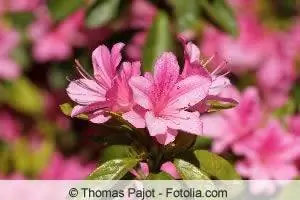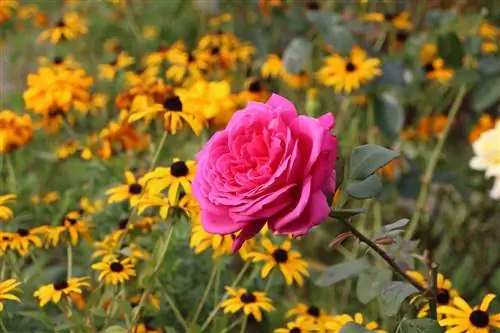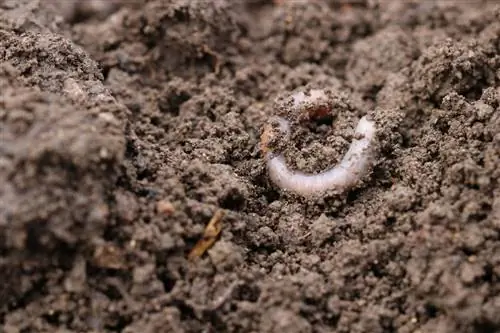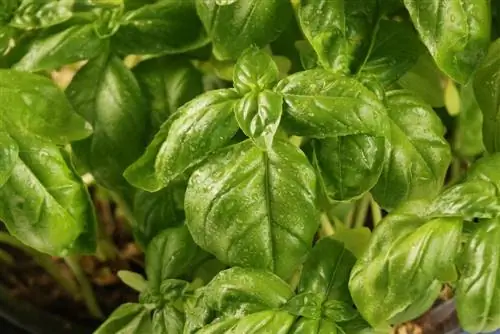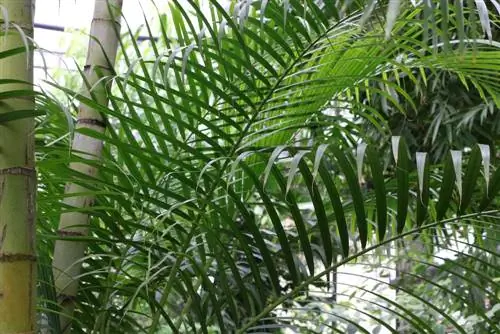- Author admin [email protected].
- Public 2023-12-17 03:39.
- Last modified 2025-01-24 12:45.
Rhododendron is native to Japan and China. The ornamental shrub places special demands on its soil. They are similar to the requirements of azaleas and heather because all plant species are heather plants. You need a pH value between 4.5 and 5.5, i.e. acidic soil. “Inkarho Rhododendron”, a very special breed, thrives on less acidic soils.
Rhododendron is an eye-catcher in the garden. There are over 1000 different varieties. Early species bloom when all other garden perennials and shrubs are still in the starting blocks, in spring. Others wait until June. However, rhododendrons place special demands on their planting substrate because of their colorful splendor, from white to yellow to red and violet flowers. In addition to a partially shaded area where the trees can develop properly, the soil should be acidic. If the soil is not naturally acidic, you can improve the soil with suitable rhododendron soil.
What is the optimal soil for rhododendrons?
Rhododendron needs a pH value between 4.5 and 5.5. The soil should contain potassium, calcium, magnesium, iron, manganese, boron, copper and zinc. A value between 5.0 and 5.5 is achieved with a mixture of four percent organic matter and less than five percent clay. This concentration can be found in nature in the marshes in front of moors. The decorative rhododendron has a high nutrient requirement, which must be covered by regular fertilizer applications. The plant needs a lot of water, but cannot tolerate waterlogging. In addition to garden soil, special soil for rhododendrons consists of:
Bark humus
Bark humus is a finely ground form of bark mulch. The humus is enriched with nitrogen and has a pH value of 5.5. It is used to improve soil. It promotes root growth and soil activity. Bark humus is available at hardware stores.
Lauberde
Leaf soil is made from composted leaves that are placed in the composter in autumn. There is also nitrogen and a layer of soil. The composting process takes two years. Leaf mold is slightly acidic.
Sand
Sand is used to improve loamy and clay soils. It ensures better ventilation and moisture drains away better. Sand has a pH value below 5.
Guano
The fertilizer is 100 percent natural fertilizer. It is made up of bird droppings, natural nitrogen, natural phosphorus and rock dust. It promotes growth and soil activity. The organic fertilizer is available from garden retailers.
Disadvantages of purchased plant substrate
Commercial substrate has peat added to it to achieve a favorable pH value for rhododendrons. Peat mining destroys the unique fauna and flora of the moors. Amateur gardeners use around two million square kilometers of peat every year. The peat now not only comes from local moors but is also imported from Lithuania and Estonia, for example. This means that the destruction of the moors is spreading across Europe. The use of peat in the garden is not without controversy. If peat dries out, it can no longer store water. It also acidifies the soil. This releases heavy metals stored in peat, which are deposited in the soil and later reabsorbed by other plants. Leaf mold and composted spruce needles can be added to normal garden soil as a peat substitute.
Tip:
Uncomposted materials remove too much nitrogen from the soil, which the rhododendron itself needs.
Mix your substrate yourself
Bark compost, garden soil, sand in equal parts make suitable rhododendron soil. Sand is used to improve heavy soils. Beef humus is responsible for the acidic environment. Charcoal or ash helps disinfection. Common fungal diseases can be prevented in this way. A moisture reservoir is clay granules. It makes the soil looser.
Tip:
Nutrient-rich humus initially covers the nutrient needs of rhododendrons. Therefore add a layer of humus to the planting hole. Excavated humus is available cheaply from civil engineering companies. Throw the excavated material through a sieve before adding it to the rhododendron soil.
Determine the pH value
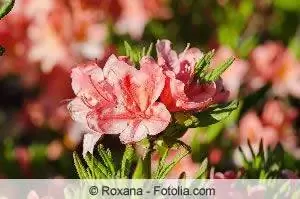
The correct pH value is essential for the growth of rhododendrons. In order for the ingredients in the garden soil to be dosed correctly, the pH value must be determined. Test strips are available from garden retailers. You also need boiled water. For the determination, a sample of the self-mixed rhododendron soil is mixed with the sterile water to form a paste. The test strip is immersed in it for around ten minutes. It colors accordingly. The pH value of the earth can now be read using the enclosed color scale.
If the pH value is too low or too high, the individual ingredients must be dosed differently. Finally, mix the rhododendron soil thoroughly.
The planting hole
Water the root ball of the rhododendron sufficiently before planting. The planting hole must be around four times as large as the root ball of the rhododendron. If the garden soil is poorly permeable, drainage is added to the planting hole as the bottom layer. Now fill up enough plant substrate so that the root ball is only around three centimeters deeper in the planting hole than in the growing pot. Rhododendrons are shallow-rooted. If the root necks are filled in and the root network does not receive enough air, the plants will wither. Now fill the remaining spaces with rhododendron soil and lightly press down the soil. Create a watering rim and water the rhododendron with eight to twelve liters of water. Later the tree will be watered weekly.
Note:
Avoid waterlogging. It leads to root rot!
Frequently asked questions
When should you mix rhododendron soil yourself?
If the soil is too calcareous or the pH value is not right, then an excavation should be made and mixed rhododendron soil should be filled in.
When should rhododendrons be transplanted?
A good date for replanting is in May after the Ice Saints. Older plants are transplanted in early autumn between September and November or in early spring between early March and mid-May. To do this, the branches are tied together to prevent them from breaking.
How do I plan the space required for rhododendron?
Older specimens can grow up to three meters high and at least as wide. Shrubs are planted individually, but also in hedges. Small species do well in pots and planters. There is a suitable breed for every space requirement.
Which location is best?
Rhododendron needs light partial shade.

